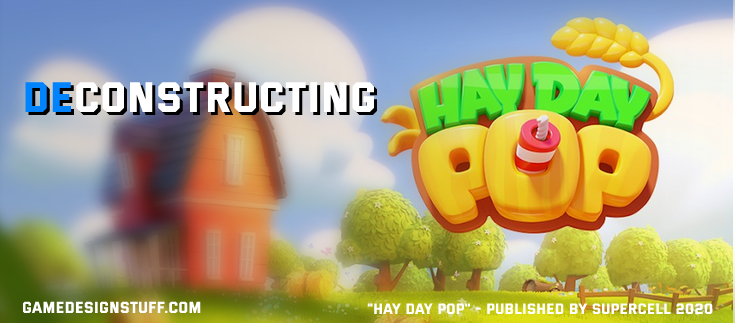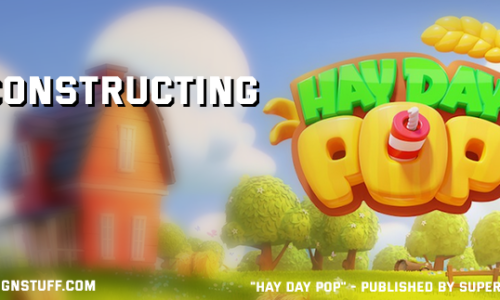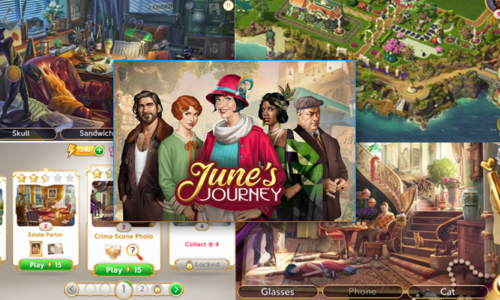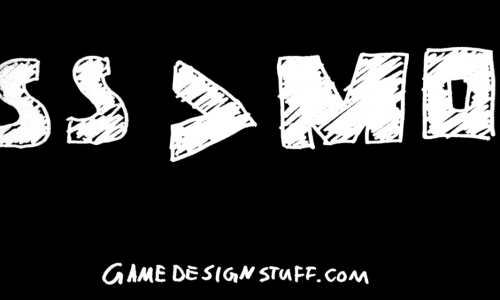Hay Day Pop is Supercell‘s latest game which is currently in soft launch. Supercell is known for their innovation that often has the capability to define the trend in mobile free to play games for years to come. As such, I was curious to learn what they’re bringing to the market now. In a market where developers often resort to known concepts to mitigate risks, we should closely watch those who dare to try something new.
Overview
- Hay Day Pop builds on top of the proven puzzle-game core loop where the progression of the player hinges on successfully finishing levels
- The innovation of Hay Day Pop is to wrap this technically very linear progression in a system that does not feel linear at all, but instead, gives players a sense of agency and choice
- Supercell hooks this scattered progression system into other monetization and progression systems – but is the core strong enough to support all of these systems?
- Hay Day Pop runs the risk of alienating their “Hay Day” audience by giving them a pure puzzle game, wrapped in the Hay Day Theme that does not speak to the “Gameplay” taste of farming-game players
- Hay Day Pop does not shy away from exposing their players early to social gameplay and even makes it part of the core loop
The Game
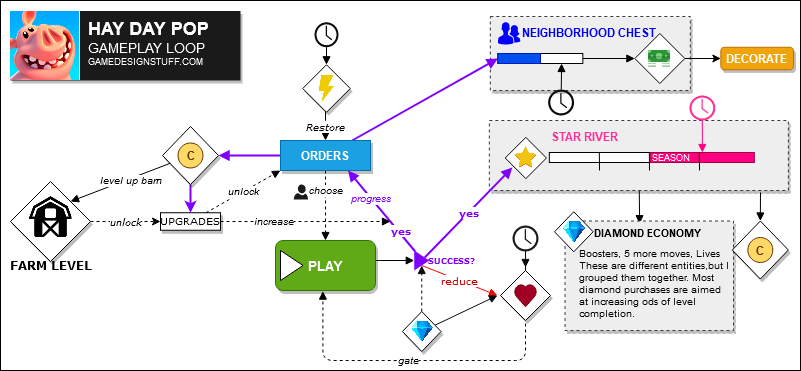
Porting the Farming Theme to a Puzzle Core
Hay Day Pop maps the farming theme well to the core loop of a puzzle game. Supercell has found fitting metaphors to wrap the linear puzzle level progression into a farm theme. Hay Day Pop makes the players feel as if they are running & growing their farm – this also includes building producers of items and decorating. However the building/ decorations options are much more limited as there is only 1 building for each “item type” and access to decoration items is scarce.
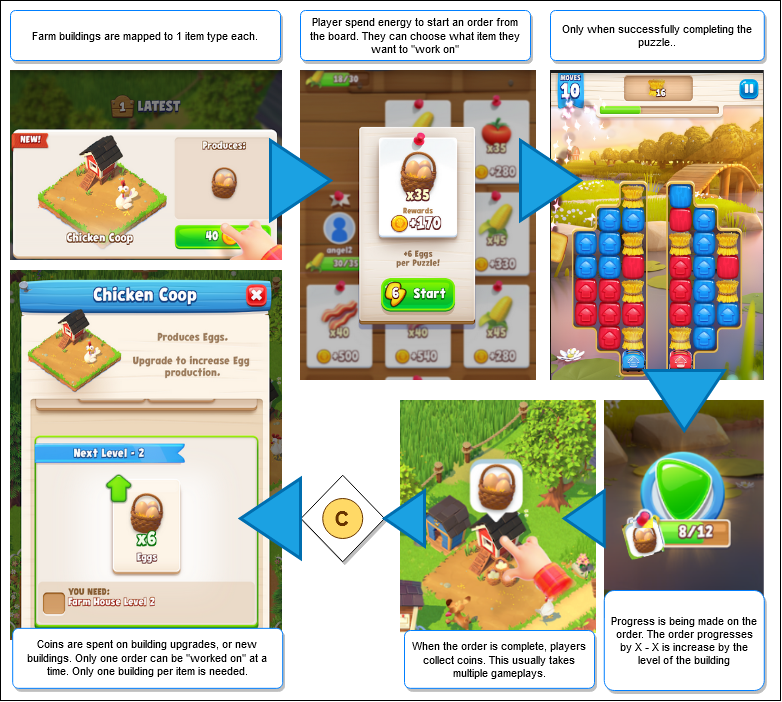
At the heart of Hay Days’ economy is time, “Hay Day Pop” uses “Successfully Completed Levels”. E.g. it takes 5 completed puzzle levels to make 60 Bacon, instead of 5 hours. Another aspect that is brought to Hay Day Pop is “order prioritization”: Hay Day Pop lets players decide what their “active order” is that they want to progress by playing levels. Under the hood there is no real impactful choice here, but players still have agency in how they want to progress, ultimately the outcomes are the same. This is not meant derogatory, it is a good example of how players don’t need meaningful choices in order to have agency.
This illusion of choice is achieved by having different producers (buildings) in the game. Each one determines the rewarded amount of items of a specific type. These items automatically fill the bar of the current order. Upgrading buildings further increases that amount. But players can’t just go for 1 specific item all the time and then upgrade only 1 building. There are 2 tuning knobs that make players diversify their buildings.
- Availability of orders: The order board asks for a variety of items. To satisfy all orders, players will want to have every building upgrade as much as they can.
- Upgrade cost / upgrade caps: Buildings cannot be upgraded to oblivion. There are exponential cost and level requirements for building upgrades. Exponential cost leads to a situation where it is the smartest thing to upgrade cheaper buildings first. For this to work, the cost needs to outgrow the yield of the buildings. So the best “reward per cost” is achieved by upgrading low cost buildings first.
Disrupting the “Saga Map”
This is the innovation of Hay Day Pop. Instead of feeling trapped on a predictable and (obviously) linear saga map, as in many other puzzle games, players have options. As you can see in the diagram, these options don’t really lead to a different outcome – players still complete 4 levels. However that does not matter, as players have options along the way.
This system leads to a state where the farms of players of the same level look more or less the same. Players can decide what to upgrade first, and what orders to take. And these choices are intertwined. But the permutations of all the players farms are only a few. Which means that players’ choices don’t really make a difference. However, it feels like they have agency along the way.
A Solid Puzzle Gameplay
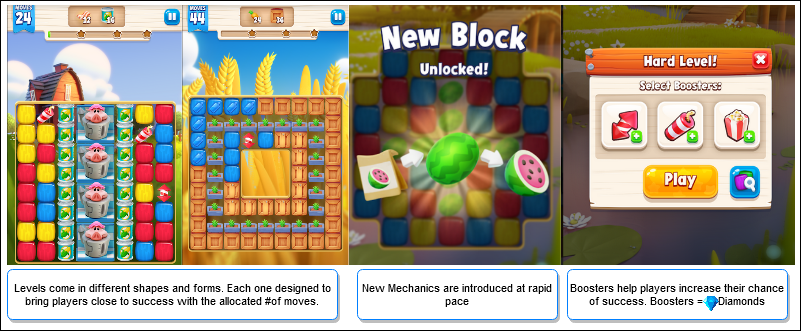
The puzzle gameplay at the core of Hay Day Pop fulfills every expectation that players could have towards a puzzle game. Great VFX and Audio, Interesting Mechanics, introduced at a surprisingly high rate. The high variety in mechanics and the designers’ capability to combine them to interesting, well, puzzles. Levels feel fresh for a very long time. From a monetization standpoint, they are very tightly designed so that players come close to completion with each attempt. This happens exceptionally consistently, which is a crucial design requirement for puzzle games: Each gameplay gets players close to completion and then monetizes this “near miss” by nudging them to use a booster / spend hard currency on “5 more moves”.
Important to note is that every (modern Candy Crush inspired) puzzle game relies on this near miss design. Players are expected to only finish a level after so many attempts. Success is not the usual outcome of a gameplay. Making it all the more rewarding if players do finish it, and additionally making booster and spending so appealing.
Monetization
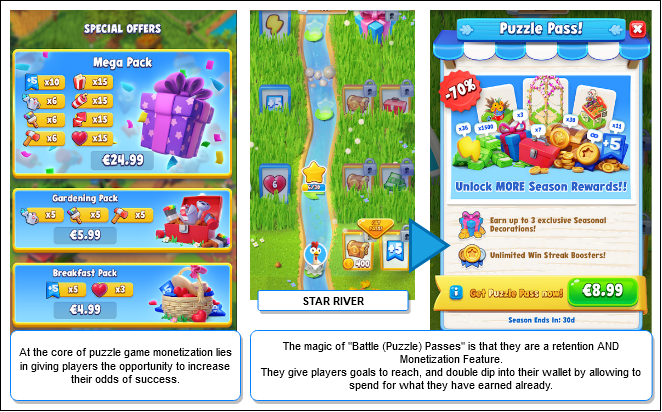
Neatly designed puzzle gameplay and near miss psychology brings us directly to the monetization of Hay Day Pop. Besides the typical boosters, more moves and lives, the game leans into 2 more monetization aspects that, in my opinion, are contradicting the established paradigms that drive monetization.
Winning Streak
For every consecutive win, the winning streak builds up. At the start of a level, players receive boosters according to their win streak. “Not losing” a win streak is another motivator to increase odds of success by using boosters or more moves (= spending diamonds)
Puzzlepass + Star River
This system works similar to battle passes. Players receive rewards for essentially playing the game. At some point the progress resets. Players are rewarded for playing the game a lot until the reset. For each reward that players get for playing the game, an additional reward is earned that can only be obtained by purchasing a Battlepass (in Hay Day Pops case = Puzzlepass).
In a nutshell: players generate value from every gameplay and can further increase their reward per gameplay by becoming a a paying player. Battlepasses are monetizing the loss aversion coming from the reset quite aggressively. If I don’t purchase, I’m missing out on a lot of the value that I have generated.
Criticism
The engine that drives these two mechanics is that players need to complete levels successfully. The main monetization driver is that the game makes it hard for players to achieve that. So on one hand, the game prevents players from achieving victory often and tries to tightly control the odds of success to be rather low (at Wooga we had Puzzle games that were tuned to be completed roughly every 200th attempt =0.5%). On the other hand it is trying to cash in on the loss aversion that comes from missing out on rewards that are generated by winning.
In more practical terms, if one wanted to increase the monetization from the star river, they’d want to increase players’ progress on the star river, thus increasing the loss aversion. But that would hurt the monetization from boosters & “more moves”. Of course you could also increase rewards from the star river, but the potential is always going to be capped by the odds of winning. I would recommend having the “star river progress” not be driven by only successful gameplays, but for any star reached in a gameplay – even if the round is not won. This could even further increase the usage of boosters as players can achieve incremental success in each round.
Social system from the get go
On Social Systems
Social systems are a powerful way to engage players. If done right, other players become the content. With the right system, players engage each other, add variety, uncertainty and a level human emotional connection. For this, the game needs to actually let players interact. Just being grouped together in a clan, does not make a game social. To make a game truly social it needs to
- Allow players to communicate, so that players know there are actual humans around
- Allow to compete/ collaborate for a common/mutual goal, to have a reason to interact and achieve things together
- Allow players to help each other by actually investing something, so that helping has meaning
- Allow players to reciprocate the help to allow players to build trust & recurring interactions
- Show that others are around
Many games shy away from exposing their players to real social gameplay in the early game. The earlier in their journey, the more likely players are to drop out of a game. This creates ghost-communities. Not enjoyable for the players who remain. Also this makes social mechanics harder to balance. Additionally, players are hard to predict, the more real interaction you allow, the more you allow for possible negative interactions. As a reaction, developers often choose to keep their players safe, and the early game experience tightly controlled.
Hay Day Pops Social Systems

Hay Day Pop throws players into a group right away. You can opt out, but the UI will guide most players to join a neighborhood. The noteworthy aspect for Hay Day Pops Social gameplay is that instead of adding mechanics as part of the social gameplay, the social aspect becomes a layer on top of existing mechanics and systems. Players do not need to learn new rules and UI’s, they play the game as usual, but benefit from playing with others with every gameplay.
- Simply playing the core loop makes players feel that they contribute to a common goal (the neighborhood chest).
- Other players names and progress is feedbacked in many places (e.g. the order board)
Other than injecting social gameplay into the core loop, Hay Day Pop makes players feel connected in different ways:
- Collect stars for the star river on other players farms
- Visiting other farms bolsters the decoration loop as it gives exposure to players farm
- Displays progress of other players in my neighborhood e.g. naming animals and incentivizes interactions among players
Summary
Hay Day Pop’s solid core puzzle gameplay caters successfully to a puzzle audience and the farm-theme + removal of the saga map has the potential to retain players better than its competitors. Currently the farm-progression layer feels like it breaks after some hours of gameplay. It is really hard to come by decorations, and visiting high level players farms shows that there is not much decoration going on. So that whole potential audience is not being satisfied currently.
Monetization wise, the game won’t do worse than it’s puzzle competitors but I have concerns that the puzzle-core-loop does not carry the weight of all the other progression/ monetization systems that are layered on top, as they are (currently) limited by the very same aspect that makes puzzle-game-monetization work (keeping the odds of success for a level low & controlled).



